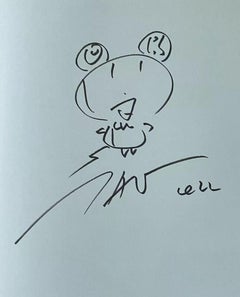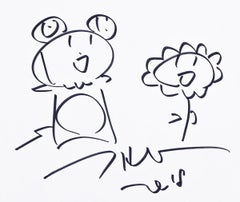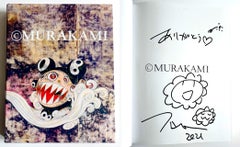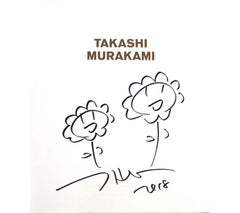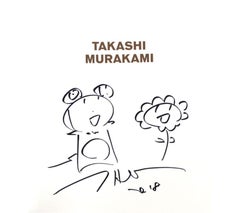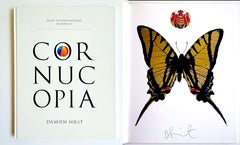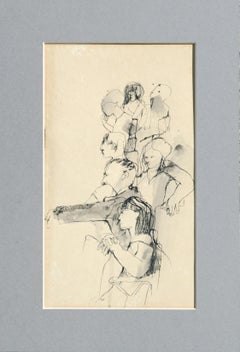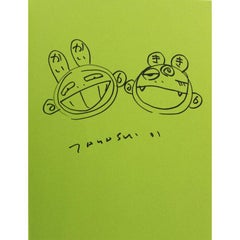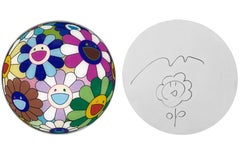Takashi Murakami Drawings and Watercolor Paintings
Japanese contemporary artist Takashi Murakami may be famous among collectors for the psychedelic flowers and chaotic cartoons that populate his prints and paintings, but artists likely know him as the theorist behind the contemporary art movement he calls “Superflat.”
Partially inspired by the Pop art of Andy Warhol, in which celebrity culture and mundane mass-produced items became the focus of bright and colorful works that both celebrated and criticized consumerism, Murakami’s Superflat encompasses painting, sculpture, digital design and more to present a subversive look at consumerism but is also an effort to blend fine art and lowbrow culture.
A multifaceted and remarkably influential artist as well as a compulsive art collector, Murakami has collaborated with brands such as Louis Vuitton, while one of his most famous Superflat works is the teddy bear on the cover of the Graduation album by American rapper Kanye West.
In 1993 Murakami earned his Ph.D. from Tokyo University of the Arts, where he was trained in nihonga, a style of painting that originated in the late 19th century by artists who worked to preserve and promote the conventions and processes associated with traditional Japanese art. While practicing nihonga, Murakami began to realize that his beliefs didn’t align with the tradition, so his art subsequently took on a satirical feel that embodied a critique of the movement. Before long, his style took a drastic turn, embracing otaku, a rising postwar cultural phenomenon among Japan’s younger crowd who loved anime and manga. (Otaku is also integral to Superflat.)
This is when Murakami’s most well-known character, Mr. DOB, was born. This anime-inspired icon, which Americans might interpret as a cross between Walt Disney’s Mickey Mouse and Lewis Carroll’s Cheshire Cat given its pronounced ears and broad and menacing grin, was part of the artist’s endeavor to elevate the otaku subculture but also to target mass consumerism. While Murakami conceived of Mr. DOB years ahead of his 2000-era Superflat theory, there is much common ground between the two. Not unlike his other creations, Murakami’s Mr. DOB is equal parts erotic, disturbing and cartoonish — an incisive mockery of the mingling of commerce and fine art so prevalent in Japanese popular culture.
Find original Takashi Murakami prints, sculptures and other art on 1stDibs.
2010s Contemporary Takashi Murakami Drawings and Watercolor Paintings
Paper, Ink
2010s Pop Art Takashi Murakami Drawings and Watercolor Paintings
Wood, Mixed Media, Permanent Marker, Screen
2010s Pop Art Takashi Murakami Drawings and Watercolor Paintings
Ink
2010s Pop Art Takashi Murakami Drawings and Watercolor Paintings
Mixed Media, Permanent Marker, Lithograph, Offset
21st Century and Contemporary Contemporary Takashi Murakami Drawings and Watercolor Paintings
Paper, Permanent Marker
21st Century and Contemporary Contemporary Takashi Murakami Drawings and Watercolor Paintings
Paper, Permanent Marker
2010s Pop Art Takashi Murakami Drawings and Watercolor Paintings
Paper, Ink, Mixed Media, Lithograph, Offset
Late 20th Century American Modern Takashi Murakami Drawings and Watercolor Paintings
Paper, Pen, Watercolor
2010s Contemporary Takashi Murakami Drawings and Watercolor Paintings
Paper, Gel Pen
2010s Contemporary Takashi Murakami Drawings and Watercolor Paintings
Paper, Ink, Acrylic, Watercolor
1960s Abstract Geometric Takashi Murakami Drawings and Watercolor Paintings
Paper, Watercolor, Pen, Pencil
Mid-20th Century Pop Art Takashi Murakami Drawings and Watercolor Paintings
Mixed Media
Mid-20th Century Pop Art Takashi Murakami Drawings and Watercolor Paintings
Mixed Media
Mid-20th Century Pop Art Takashi Murakami Drawings and Watercolor Paintings
Mixed Media
1990s Pop Art Takashi Murakami Drawings and Watercolor Paintings
Archival Ink, Archival Paper, Lithograph, Offset
Mid-20th Century Pop Art Takashi Murakami Drawings and Watercolor Paintings
Mixed Media
1980s Abstract Expressionist Takashi Murakami Drawings and Watercolor Paintings
Permanent Marker
1910s Fauvist Takashi Murakami Drawings and Watercolor Paintings
Ink, Pen
21st Century and Contemporary Contemporary Takashi Murakami Drawings and Watercolor Paintings
Permanent Marker, Paper
Early 2000s Pop Art Takashi Murakami Drawings and Watercolor Paintings
Fiberglass
Takashi Murakami drawings and watercolor paintings for sale on 1stDibs.
Artists Similar to Takashi Murakami
- Who is Takashi Murakami?1 Answer1stDibs ExpertMarch 22, 2022Takashi Murakami is a Japanese contemporary artist. He coined the term "Superflat" to describe his work, which draws inspiration from two-dimensional anime cartoons and manga comics popular in Japan. Murakami was born in Tokyo, Japan, on February 1, 1962. You'll find a collection of Takashi Murakami art on 1stDibs.
- When was Takashi Murakami born?1 Answer1stDibs ExpertMarch 22, 2022Takashi Murakami was born on February 1, 1962, in Tokyo, Japan. He studied at the Tokyo University of the Arts, earning a Ph.D. in art. He currently lives in both Tokyo and New York City. On 1stDibs, find a collection of Takashi Murakami art.
- Where was Takashi Murakami born?1 Answer1stDibs ExpertMarch 22, 2022Takashi Murakami was born in Tokyo, Japan, on February 1, 1962. He received a Ph.D. in art from the Tokyo University of the Arts in 1993. During the 1990s, he shifted from the traditional Japanese painting style of nihonga and began creating bold, colorful works inspired by anime and manga. He calls his style Superflat. On 1stDibs, find a range of Takashi Murakami art.
- 1stDibs ExpertAugust 8, 2024Artwork by Takashi Murakami is so expensive, largely due to a great demand for a limited supply of pieces. Murakami may be famous among collectors for the psychedelic flowers and chaotic cartoons that populate his prints and paintings, but artists likely know him as the theorist behind the contemporary art movement he calls “Superflat." Partially inspired by the Pop art of Andy Warhol, in which celebrity culture and mundane mass-produced items became the focus of bright and colorful works that both celebrated and criticized consumerism, Murakami’s Superflat encompasses painting, sculpture, digital design and more to present a subversive look at consumerism. It is also an effort to blend fine art and lowbrow culture. The Japanese artist has collaborated with brands such as Louis Vuitton, and one of his most famous Superflat works is the teddy bear on the cover of the Graduation album by American rapper Kanye West. These collaborations and connections to pop culture have increased Murakami's fame and contributed to the demand for his work. On 1stDibs, shop a diverse assortment of Takashi Murakami art.
- 1stDibs ExpertMarch 22, 2022You can buy Takashi Murakami in a variety of ways. Options include working with a reputable art dealer or buying through an auction house. You can also find his artwork on various online platforms. Shop a variety of Takashi Murakami art on 1stDibs.
- 1stDibs ExpertApril 5, 2022Takashi Murakami’s aesthetic has been described as “superflat” - a style that incorporates 2D art and colorful designs while balancing the line between fine art and pop art. Shop a selection of Takashi Murakami’s pieces from some of the world’s top art dealers on 1stDibs.
- 1stDibs ExpertMarch 22, 2022Over the years, Takashi Murakami has worked with many designers. His collaboration with Louis Vuitton in 2003 opened the doors to collaborations with Kanye West, Billionaire Boys Club, Kaws, Hublo and Pharrell Williams. On 1stDibs, shop a variety of Takashi Murakami art.
- 1stDibs ExpertMarch 22, 2022Takashi Murakami lives and works in both Tokyo, Japan, and New York, New York. He was born in Tokyo on February 1, 1962, and he graduated from the Tokyo University of the Arts with a Ph.D. in art. On 1stDibs, find a collection of Takashi Murakami art.
- 1stDibs ExpertApril 5, 2024Takashi Murakami's art is displayed in many places. Works by the Japanese contemporary artist are in the collections of the Museum of Modern Art in New York City, the Museum of Fine Arts in Boston, the Broad in Los Angeles and many other museums around the world. Major institutions also regularly present temporary exhibitions of Murakami's work. Find a collection of Takashi Murakami art on 1stDibs.
- 1stDibs ExpertMarch 22, 2022The meaning of Takashi Murakami's art varies from piece to piece. The artist creates what he calls "Superflat" art by using techniques from traditional Japanese painting to depict subjects inspired by Japanese pop culture and anime and manga art. On 1stDibs, shop a selection of Takashi Murakami art.
- 1stDibs ExpertMarch 22, 2022In Tokyo, you can see Takashi Murakami at the Mori Art Museum as well as in various galleries. The artist's work is also on display at other museums around the world, including The Museum of Modern Art in New York, New York, and the Museum of Fine Arts in Boston, Massachusetts. On 1stDibs, find a selection of Takashi Murakami art.
- 1stDibs ExpertMarch 22, 2022Takashi Murakami became famous around the world due to his collaborations with western designers. In 2003, his collaboration with Louis Vuitton elevated him to international celebrity status. Prior to that, he was mostly known only in art circles. On 1stDibs, find a range of Takashi Murakami art.
- 1stDibs ExpertApril 23, 2024Takashi Murakami has used a variety of materials in his work, and his characters have appeared across a wide range of media. His sculptures include silkscreened maple hardwood skateboard decks and cast vinyl figurines (polyvinyl chloride), and he has created silkscreen prints, ink drawings with permanent marker, and offset color lithographs on wove paper. Murakami is a filmmaker, too, and has produced paintings in oil and acrylics. The artist is supported by a large production studio and artist management company that he founded called Kaikai Kiki Co., Ltd.
Japanese contemporary artist Takashi Murakami may be famous among collectors for the psychedelic flowers and chaotic cartoons that populate his prints and paintings, but artists likely know him as the theorist behind the contemporary art movement he calls “Superflat.”
Partially inspired by the Pop art of Andy Warhol, in which celebrity culture and mundane mass-produced items became the focus of bright and colorful works that both celebrated and criticized consumerism, Murakami’s Superflat encompasses painting, sculpture, digital design and more to present a subversive look at consumerism but is also an effort to blend fine art and lowbrow culture.
Find Takashi Murakami art for sale on 1stDibs. - 1stDibs ExpertMarch 13, 2024Takashi Murakami's most famous piece is open to debate. The Japanese artist has created a number of works that have become widely known. They include Super Nova; Flowers, Flowers, Flowers; Who's Afraid of Red, Yellow, Blue and Death; 727 and Chakras Open and I Drown Under the Waterfall of Life. His most well-known character is Mr. DOB, an anime-inspired icon, which Americans might interpret as a cross between Walt Disney's Mickey Mouse and Lewis Carroll's Cheshire Cat given its pronounced ears and broad, menacing grin. Explore a collection of Takashi Murakami art on 1stDibs.
- 1stDibs ExpertMarch 22, 2022Takashi Murakami is a Japanese contemporary painter and sculptor. Some critics refer to him as a Japanese pop artist. The artist calls his style Superflat, saying that it stems from the two-dimensional images found in anime and manga. On 1stDibs, find a variety of Takashi Murakami art.
- 1stDibs ExpertApril 5, 2022High-fashion retailer Louis Vuitton and color-pop artist Takashi Murakami collaborated in 2003. Murakami was invited by creative director Marc Jacobs to add a little color to the fashion house’s signature monogram collection. Bag some of the designs for yourself by shopping the collaboration on 1stDibs.
- 1stDibs ExpertFebruary 7, 2024The type of paint that Takashi Murakami uses is acrylic paint. This is a departure from the traditions of Nihonga painting that inform the artist's work. Typically, painters working in this style use natural pigments, but by opting for a mix of acrylic paint and digital media, Murakami gives his works a contemporary Pop art sheen. Shop a collection of Takashi Murakami art on 1stDibs.
- 1stDibs ExpertNovember 13, 2024Takashi Murakami's art style is called Superflat. Partially inspired by the Pop art work of Andy Warhol, in which celebrity culture and mundane mass-produced items became the focus of bright and colorful pieces that both celebrated and criticized consumerism, Murakami’s Superflat encompasses painting, sculpture, digital design and more to present a subversive look at consumerism. It’s also an effort to blend fine art and lowbrow culture. A multifaceted and influential artist, Murakami has collaborated with brands such as Louis Vuitton. One of his most famous Superflat works is the teddy bear on the cover of the Graduation album by American rapper Kanye West. Shop a collection of Takashi Murakami art on 1stDibs.
